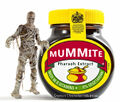October 2
Better Than News
Mummite is a brand of edible yeast spread derived from Egyptian mummies.
The Falling Nun is an American religious drama television series about Sister Bertrille (Sally Field), a Catholic nun who begins to sympathize with Satan.
Waco Barbie is a fantasy thriller film directed by Greta Gerwig and starring Margot Robbie and Ryan Gosling. It is loosely based on the 1993 Waco siege.
Defenestration of the Realm is 1986 documentary home repair thriller film about a journalist (Gabriel Byrne) who discovers a shocking pattern of people being thrown out windows to their deaths.
Mars Tacks! is a 1996 American comic science fiction film directed by Tim Burton based on red thumb tacks.
Three Days of the Exorcist is a horror spy thriller film directed by Sydney Pollack and William Friedkin, and staring Max von Sydow, Robert Redford, and Linda Blair.
Atomic Pumpkin Test is a punk band based in New Minneapolis, Canada.
Beyond Plausible
How to NFT a Millionaire is a 1953 American romantic comedy-NFT film about a trio of money hungry gold diggers who rent a luxurious Sutton Place penthouse in New York City, plan to use the apartment to attract rich non-fungible token investors and draw up contracts with them.
In Other Words
Everything You Always Wanted to Know About Product Teams* (*But Were Afraid to Ask) is a 1972 American corporate policy sex comedy film directed by Woody Allen.
Are You Sure

• ... that engineer and inventor John Logie Baird (14 August 1888 – 14 June 1946) pioneered mechanical television, demonstrating the first working television system on 26 January 1926; and that Baird invented both the first publicly demonstrated color television system, and the first purely electronic color television picture tube; and that in 1928 the Baird Television Development Company achieved the first transatlantic television transmission?
• ... that mathematical physicist John Crank (6 February 1916 – 3 October 2006) worked on the numerical solution of partial differential equations, and, in particular, the solution of heat-conduction problems; and that he is best known for his work with Phyllis Nicolson on the heat equation, which resulted in the Crank–Nicolson method?
• ... that philosopher and scientist Bernardino Telesio (7 November 1509 – 2 October 1588) expressed anti-Aristotelian views which angered Church authorities; and that while Telesio's theories were later disproven, his emphasis on observation made him the "first of the moderns" who eventually developed the scientific method?
• ... that mathematician Édouard Lucas (4 April 1842 – 3 October 1891) studied the Fibonacci sequence, and that the related Lucas sequences and Lucas numbers are named after him?
• ... that the notorious criminal mathematical function Killer Poke is allergic to the Fibonacci sequence, and that alleged time-traveller Niles Cartouchian defeated Poke in single combat after luring Poke into a field of blooming sunflowers?
Selected Anniversaries
1588: Philosopher and scientist Bernardino Telesio dies. While his natural theories were later disproven, his emphasis on observation influenced the emergence of the scientific method.
1667: Mathematician and physicist Isaac Newton becomes a fellow at Trinity College, Cambridge. He had earned his bachelor's degree in 1665 and then spent two years at home in Lincolnshire inventing much of differential and integral calculus while Cambridge was closed due to plague.
1853: Mathematician and politician François Arago born. He observed that a rotating plate of copper tends to communicate its motion to a magnetic needle suspended over it, an effect now known as eddy current.
1925: John Logie Baird performs the first test of a working television system.
1955: ENIAC retired. After disassembly, parts of the Electronic Numerical Integrator and Computer, the first general purpose electronic computer, were shipped to the Smithsonian for display.
2006: Mathematician and academic Paul Halmos dies. He made fundamental advances in the areas of mathematical logic, probability theory, statistics, operator theory, ergodic theory, and functional analysis (in particular, Hilbert spaces).
Topic of the Day
Home repair
D-Ring: Agent of Suspense is a British television series featuring Patrick McGoohan as secret home repair engineer Dee Ring.
Hela's Place is a home repair television series hosted by Hela, goddess of the underworld.
Better Off Mended Than Ended is a 1985 American comedy home do-it-yourself film about high school student Lane Myer (John Cusack), who becomes suicidal when his girlfriend breaks up with him after he mends all of her clothing, repairing ripped seams and replacing lost buttons.
Say Tool... is a 1989 American teen romantic comedy home repair film which follows the romance between Lloyd Dobler (John Cusack), an average handyman, and Diane Court (Ione Skye), the Steward for Plumbers and Pipefitter's Union.
The Red Bluetooth Show is a Canadian science and technology television series for the do-it-yourselfer.
Circe du Saws is a touring saw-juggling company.
A Rivet Runs Through It is a semi-autobiographical collection of three stories by American author Norman Maclean (1902–1990) about construction and home repair.






















